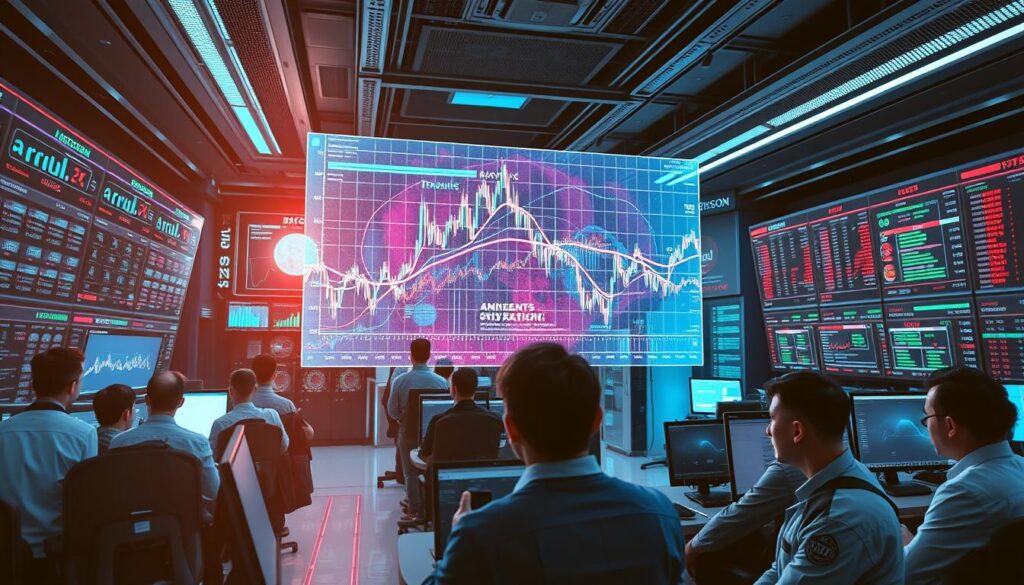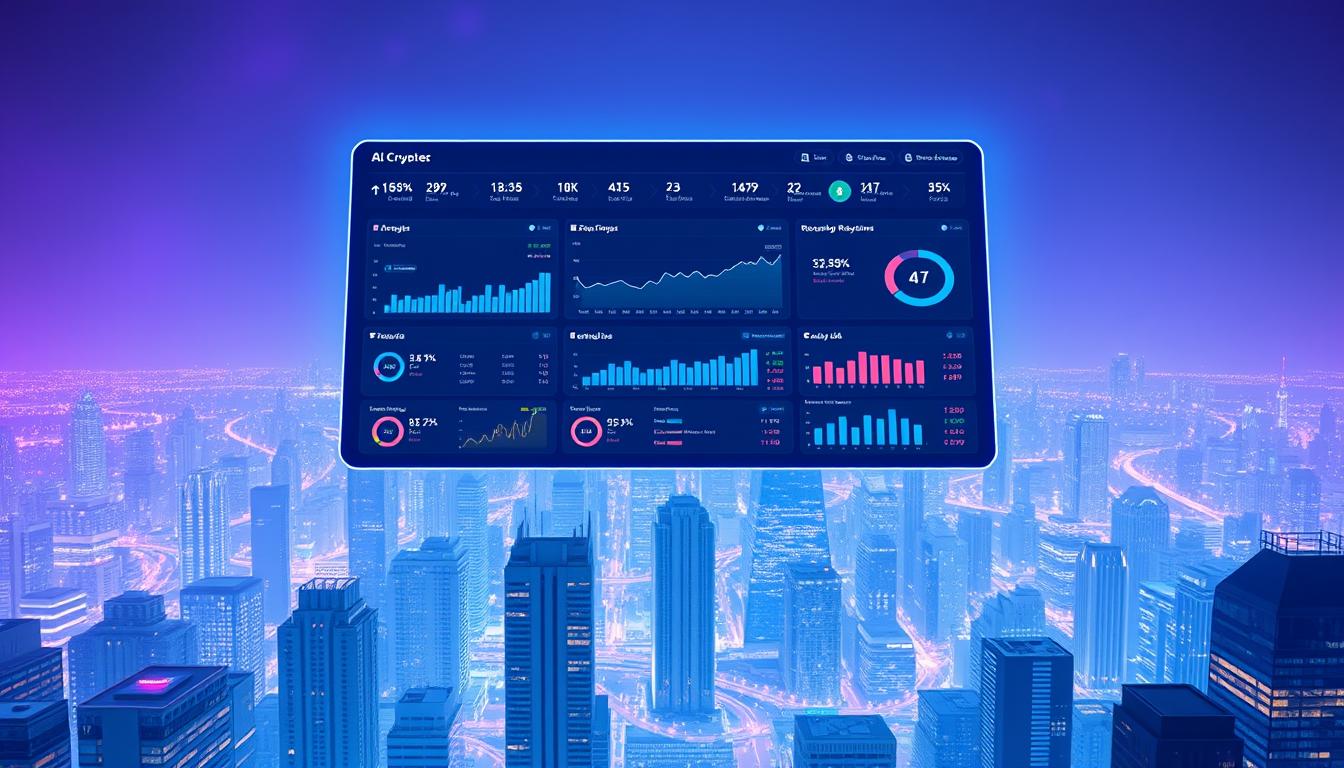Now Reading: Discover Effective AI Powered Crypto Derivative Trading Strategies
- 01
Discover Effective AI Powered Crypto Derivative Trading Strategies
Discover Effective AI Powered Crypto Derivative Trading Strategies

The world of digital currencies moves at lightning speed. Traditional methods struggle to keep pace with market fluctuations.
Advanced technology now offers powerful solutions for market participants. These systems analyze enormous amounts of information in real time.
They operate continuously, capturing opportunities that human traders might miss. This eliminates emotional decision-making that often leads to losses.
This guide explores how automated systems transform complex financial instruments. We will cover risk management and practical implementation across various platforms.
Both new and experienced investors will find valuable insights here. The content focuses on systematic approaches that work around the clock.
Key Takeaways
- Automated systems process market data faster than human traders
- Technology removes emotional bias from investment decisions
- Continuous operation captures opportunities in volatile markets
- Complex financial instruments benefit from sophisticated analysis
- Systematic approaches provide consistency in unpredictable environments
- Risk management becomes more precise with data-driven insights
Understanding the Evolution of AI in Crypto Trading
The journey of automated systems in financial exchanges began long before digital currencies emerged. Early systems focused on basic rule-based approaches in traditional markets.

Historical Perspective of AI in Financial Markets
In the 1980s and 1990s, simple algorithms entered stock exchanges. These systems automated basic trading tasks that humans previously handled manually.
Machine learning models later enabled pattern recognition and predictive analytics. This marked a significant shift from rule-based to adaptive systems.
Modern Developments in AI Trading Technologies
Today’s systems use deep learning neural networks and reinforcement learning. They process enormous amounts of market data in real time.
Natural language processing analyzes sentiment across news and social media. These technologies were once exclusive to institutional traders.
Now retail participants access sophisticated tools through various platforms. The evolution continues as computational power increases.
Fundamentals of Crypto Derivatives and Market Dynamics
Contracts based on underlying digital assets offer traders unique opportunities beyond simple coin ownership. These financial instruments derive their value from popular cryptocurrencies like Bitcoin and Ethereum.
Unlike spot trading where you directly purchase coins, derivatives let you speculate on price movements. You never actually own the underlying digital currencies.
Three main types dominate this market space. Futures contracts lock in prices for specific future dates.
Options provide the right to buy or sell at predetermined levels. Perpetual contracts function like futures but have no expiration dates.

These instruments serve critical functions in digital asset markets. They enhance liquidity by creating multiple trading avenues.
Derivative markets contribute significantly to price discovery. They reveal collective expectations about future cryptocurrency valuations.
Risk management represents another key benefit. Traders use derivatives to hedge against volatile price swings.
Market dynamics include leverage opportunities and margin requirements. These factors influence both potential returns and risk exposure.
Understanding these fundamentals helps navigate complex digital asset environments. They form the foundation for sophisticated market approaches.
AI powered crypto derivative trading strategies
Today’s financial landscape requires adaptive systems that process real-time market information. These approaches help participants navigate volatile conditions with greater precision.
Momentum-based systems identify trending price movements before they become obvious. They capitalize on sustained directional shifts in market valuations.

Mean reversion techniques spot when prices deviate significantly from historical averages. The systems then predict likely returns to normal ranges, optimizing timing.
Arbitrage approaches monitor multiple exchanges simultaneously. They exploit pricing discrepancies faster than humanly possible for consistent gains.
Sentiment-driven methodologies analyze social media and news sources. Natural language processing translates qualitative sentiment into quantitative signals.
Market-making systems provide liquidity while managing risk exposure. They continuously adjust bid-ask spreads based on volatility and order flow.
Trend-following approaches combine multiple technical indicators with pattern recognition. This identifies high-probability directional moves in complex instruments.
The most effective systems dynamically adapt to changing conditions. They automatically adjust parameters and risk exposure as market structure evolves.
Traders often combine multiple approaches into diversified portfolios. This reduces correlation risk and provides more consistent returns across different environments.
The Rise of AI Trading Bots and Their Capabilities
Sophisticated software now handles complex market operations with unprecedented efficiency. These automated systems have become essential for modern investors seeking consistent results.

Different types serve distinct market functions. Grid systems place orders at preset intervals to profit from price fluctuations. Dollar-cost averaging approaches systematically accumulate positions over time.
Arbitrage tools exploit pricing differences across multiple exchanges. More advanced systems combine multiple methodologies for optimal performance.
These platforms process real-time data with remarkable speed. They respond to opportunities within milliseconds, operating continuously without fatigue.
Customization features allow precise risk management. Users can define stop-loss levels, specify trading pairs, and adjust strategy parameters.
The learning curve varies across different platforms. Beginner-friendly options offer simplicity, while complex systems provide greater control for experienced participants.
Integration capabilities connect these tools with exchange APIs. This enables comprehensive automation across multiple assets and markets.
Harnessing Machine Learning for Predictive Market Analysis
Market forecasting enters a new era with computational intelligence. Systems now identify patterns humans might overlook through advanced algorithms.
These technologies process enormous historical datasets to recognize recurring behaviors. They continuously improve their predictive accuracy as they encounter new information.
Three primary approaches dominate this field. Supervised models learn from labeled historical data to make future projections.
Unsupervised techniques discover hidden patterns without predefined labels. Reinforcement systems optimize through trial and error simulations.
Effective pattern recognition requires quality input data. Systems analyze price movements, trading volumes, and market indicators simultaneously.
| Learning Approach | Data Requirement | Primary Strength | Common Applications |
|---|---|---|---|
| Supervised Learning | Labeled historical data | Accurate price predictions | Trend forecasting |
| Unsupervised Learning | Raw market data | Pattern discovery | Anomaly detection |
| Reinforcement Learning | Trial data | Strategy optimization | Portfolio management |
Model training involves careful validation to prevent overfitting. Backtesting ensures reliability before implementation.
These predictions inform critical decisions about entry points and position sizing. They bring consistency to volatile environments through data-driven insights.
Managing Volatility in Crypto Markets with AI
Volatility represents both a challenge and opportunity for participants in digital asset markets. These conditions create rapid price movements that can generate significant gains or losses.
Digital markets experience higher turbulence than traditional financial systems. Factors include continuous operation, regulatory uncertainty, and speculative activity.
Advanced systems monitor real-time data to detect volatility patterns. They analyze trading volume spikes and order book imbalances.
These tools forecast turbulent periods before they intensify. This allows for strategic adjustments to position sizing and risk parameters.
Adaptive approaches automatically modify techniques during different market conditions. They might widen profit targets during high volatility or tighten stops during extreme swings.
The psychological benefit is equally important. Automated execution removes emotional reactions that often lead to poor decisions during market panics.
Systems trained solely on historical data may struggle during unprecedented events. The most effective solutions incorporate adaptive algorithms that adjust to novel situations.
Specific risk management techniques include dynamic position sizing and correlation analysis. These methods help maintain consistent risk exposure across changing market trends.
Integrating Exchange Accounts for Seamless AI Trading
Secure integration between platforms and exchanges forms the backbone of automated systems. This connection enables real-time data flow and order execution without manual intervention.
Application Programming Interfaces (APIs) serve as the communication bridge. Traders generate unique keys within their exchange accounts to grant controlled access.
Proper permission configuration protects your assets. Restrict API keys to trading functions only, excluding withdrawal capabilities. Implement IP whitelisting for additional security layers.
Multi-exchange connectivity offers significant advantages. You can monitor price differences across venues simultaneously. This setup enables arbitrage opportunities and diversified portfolio management.
| Permission Type | Security Level | Recommended Use | Risk Factor |
|---|---|---|---|
| Read-Only | High | Data Analysis | Low |
| Trading Enabled | Medium | Automated Execution | Medium |
| Withdrawal Allowed | Low | Not Recommended | High |
Platforms like 3Commas consolidate multiple exchange connections into one interface. This simplifies portfolio tracking and strategy implementation across different markets.
Always test integrations using demo accounts before live deployment. Verify that orders execute correctly and data syncs accurately between systems. For those seeking comprehensive tools, explore the best AI crypto trading platform options available today.
Stable internet connectivity ensures uninterrupted operation. Consider backup connection methods to prevent missed opportunities during network issues.
Building Robust Risk Management with AI Insights
Every successful market participant understands that limiting losses is as important as capturing gains. Advanced systems now elevate protection from simple stops to comprehensive portfolio optimization.
Position sizing determines how much capital to risk on each opportunity. Smart systems calculate optimal amounts based on current volatility and account value.
Stop-loss approaches have evolved beyond basic price triggers. Modern tools use volatility-adjusted stops and trailing mechanisms that protect profits during favorable moves.
Portfolio-level analysis identifies concentration risks across different assets. These systems recommend diversification adjustments to reduce vulnerability to single market movements.
| Risk Type | Management Approach | Technology Enhancement |
|---|---|---|
| Market Risk | Dynamic Position Sizing | Real-time Volatility Analysis |
| Liquidity Risk | Multi-exchange Connectivity | Order Book Depth Monitoring |
| Operational Risk | System Redundancy | Continuous Performance Checks |
Performance metrics like Sharpe ratios help assess returns relative to risk taken. Maximum drawdown statistics reveal worst-case scenario impacts.
These insights help investors make better choices by quantifying abstract dangers. They simulate various market conditions to test strategy resilience before implementation.
Advanced Trading Strategies and Signal Optimization
Moving beyond basic approaches requires sophisticated methods that process multiple data streams simultaneously. These advanced techniques help market participants achieve better results through systematic execution.
Professional-grade approaches combine various indicators and pattern recognition. They analyze complex chart formations across different timeframes.
Technical Analysis Techniques with AI
Traditional chart reading transforms when enhanced by computational systems. These tools identify head-and-shoulders patterns and triangle formations automatically.
Support and resistance levels become more precise through machine learning. The systems test thousands of indicator combinations to find optimal settings.
Signal optimization involves extensive backtesting across historical market conditions. This process identifies configurations with the best risk-adjusted returns.
Overcoming Implementation Challenges
Deploying complex methods presents several practical obstacles. Data quality issues and computational requirements can impact performance.
Overfitting remains a significant concern when developing sophisticated approaches. Systems must perform well on unseen data, not just historical patterns.
Testing procedures include walk-forward analysis and paper trading periods. These validate behavior before live deployment, reducing implementation risks.
Customization allows adjustment for different risk tolerance levels and time horizons. Even advanced systems experience drawdowns and require realistic expectations.
Leveraging Automated Trade Execution for Efficiency
The conversion of trading signals into actual positions represents a critical operational phase. Modern systems translate analysis into precise order parameters automatically. This eliminates manual intervention delays.
Various order types serve different execution needs. Market orders provide immediate fills at current prices. Limit orders target specific price levels for better control.
Advanced algorithms minimize market impact during large executions. TWAP systems distribute orders evenly over time. VWAP approaches align with volume patterns for optimal pricing.
Speed advantages are substantial compared to manual methods. Automated platforms respond within milliseconds to market opportunities. This captures favorable prices that human traders might miss.
Continuous operation ensures no missed opportunities across time zones. Systems like Freqtrade run 24/7 with Web UI monitoring. Telegram integration provides real-time alerts for activity tracking.
Reliability features include backup servers and error handling procedures. Multiple exchange connections prevent single-point failures. Detailed execution logs enable thorough performance analysis.
Enhancing User Experience with AI-Driven Interfaces
Modern trading platforms prioritize user experience through intuitive design and smart features. These systems make sophisticated technology accessible to every participant.
A clean dashboard provides immediate portfolio overviews. Users see real-time profit metrics and active positions at a glance.
Customization options let traders arrange interface elements to match their workflow. They can create personalized watchlists and set custom alerts.
Mobile access ensures continuous monitoring from smartphones and tablets. Responsive design adapts layouts for different screen sizes.
Intelligent assistance features guide new users through setup processes. Contextual help appears when needed, reducing learning curves.
| Interface Feature | Beginner Benefit | Advanced User Value |
|---|---|---|
| Guided Setup Wizards | Step-by-step configuration | Time-saving templates |
| Customizable Dashboards | Simplified default views | Advanced metric displays |
| Mobile Applications | Basic monitoring | Full strategy control |
| Natural Language Input | Simple command entry | Complex parameter setting |
Progressive disclosure hides complexity until users need advanced tools. This balance serves both novice and experienced participants effectively.
Well-designed platforms consolidate multiple exchange accounts into unified interfaces. Users manage diverse assets through single sign-on access.
Securing Your Assets with Advanced Encryption and AI Monitoring
Safeguarding investments demands a multi-layered approach combining encryption and intelligent monitoring. Modern platforms implement robust security measures to protect your assets and personal information.
These systems create a protective barrier around your financial operations. They work continuously to detect and prevent unauthorized access.
AI-driven Security Protocols
Intelligent monitoring systems analyze patterns in real-time. They flag unusual activities that might indicate security threats.
Behavioral analysis tracks normal operation patterns. The system alerts you when deviations suggest potential compromise.
Predictive modeling anticipates emerging threats before they materialize. This proactive approach strengthens your security infrastructure.
Best Practices for API Integration
Always restrict API permissions to essential functions only. Never enable withdrawal capabilities for automated tools.
Use IP whitelisting to limit access to trusted locations. Regularly rotate your API credentials for added protection.
Choose platforms with transparent security policies and regular audits. This ensures your integration remains secure over time.
Proper configuration prevents unauthorized access to your trading accounts. These practices form the foundation of safe automated operations.
Community Engagement and Collaborative Trading Insights
Active community participation creates learning pathways that individual analysis cannot match. Market participants gain access to diverse perspectives through shared experiences.
Specialized forums and social media groups serve as valuable meeting places. Reddit communities and Discord servers host lively discussions about market movements.
These platforms allow traders to exchange practical tips and strategy adjustments. Collaborative environments help identify emerging patterns that might escape solitary observation.
Seasoned participants often share their approaches through detailed explanations. Open-source code repositories provide tangible examples of effective methodologies.
Intelligent tools can enhance these interactions by filtering relevant content. They connect users with similar interests and highlight quality discussions.
Critical evaluation remains essential when consuming community information. Verify claims through independent research and recognize potential biases.
Contributing personal experiences completes the knowledge exchange cycle. Answering questions and sharing insights strengthens the entire community ecosystem.
Utilizing Supplementary Resources for Continuous Learning
Knowledge acquisition represents an ongoing process for participants navigating evolving markets. Staying current requires accessing diverse educational materials that enhance understanding.
Tutorials, Webinars, and Strategy Guides
Various platforms offer comprehensive learning materials for skill development. Video tutorials demonstrate practical application of complex concepts.
Live webinars feature experienced professionals sharing real-world insights. Written guides provide detailed explanations of methodological approaches.
Structured learning paths progress from foundational to advanced topics. Interactive courses include hands-on exercises for practical experience.
| Resource Type | Learning Format | Skill Level | Practical Value |
|---|---|---|---|
| Video Tutorials | Visual Demonstration | Beginner to Advanced | High |
| Live Webinars | Interactive Sessions | Intermediate | Very High |
| Strategy Guides | Written Documentation | All Levels | Medium to High |
| Interactive Courses | Hands-on Learning | Beginner to Expert | Highest |
Practical application through simulated environments builds confidence. Regular engagement with market news maintains current awareness.
Learning from both successes and failures informs future improvements. This continuous development process separates consistent performers from occasional participants.
Future Trends: Innovations in AI-Driven Crypto Trading
The frontier of digital asset markets continues to expand with groundbreaking technological innovations. Advanced computational systems are evolving toward more sophisticated machine learning architectures.
Transformer models adapted from language processing now analyze complex market relationships. Graph neural networks map intricate connections between different digital assets.
Alternative data sources are becoming increasingly important for market analysis. Systems now incorporate satellite imagery, IoT device information, and blockchain analytics. These diverse inputs create more comprehensive market pictures.
Quantum computing presents exciting possibilities for solving complex optimization problems. This technology could enable previously impossible predictive modeling capabilities.
Decentralized systems built on blockchain infrastructure offer transparent, auditable algorithms. They create trustless execution environments that eliminate counterparty risks.
Regulatory frameworks are developing to address algorithmic oversight requirements. Compliance standards will shape how platforms implement these advanced technologies.
The democratization trend makes sophisticated tools accessible to more participants. This reduces barriers to entry and potentially changes market dynamics.
Ethical considerations around market manipulation and fairness require careful attention. Developers must consider responsibilities toward overall market stability.
These innovations promise more efficient markets and enhanced risk management capabilities. For comprehensive guidance on implementing these technologies, explore this complete guide to advanced market systems.
Conclusion
Sophisticated algorithmic tools now offer unprecedented capabilities for navigating complex digital asset environments. These systems process information faster than human capabilities allow, operating continuously across all market conditions.
The journey from understanding market fundamentals to implementing automated approaches provides a comprehensive framework for success. Both beginners and experienced participants can leverage these technologies to enhance their market participation.
Realistic expectations remain crucial when deploying automated systems. They serve as powerful enablers rather than guaranteed profit solutions, requiring proper configuration and ongoing monitoring.
Start by selecting an appropriate platform and testing with paper trading. Join communities and commit to continuous learning for optimal results.
These tools provide competitive advantages in increasingly efficient markets. The future promises even more innovative approaches for those who embrace technological advancement.
FAQ
What are the main benefits of using machine learning for crypto derivative strategies?
Machine learning algorithms analyze vast amounts of historical data and real-time market conditions to identify complex patterns. This provides traders with predictive insights and more accurate buy/sell signals, enhancing decision-making for trade execution.
How do automated trading platforms manage risk in volatile cryptocurrency markets?
These platforms use sophisticated risk management tools that monitor portfolio exposure in real-time. They can automatically adjust positions based on predefined parameters, helping to protect assets during sudden price movements.
What features should I look for in an AI trading platform for derivatives?
Key features include robust backtesting capabilities, seamless exchange integration via secure API, advanced charting tools for technical analysis, and customizable algorithms. A user-friendly interface for strategy optimization is also crucial.
Can these strategies be applied to different types of crypto assets?
Yes, advanced algorithmic strategies can be adapted for various assets, including futures, options, and perpetual swaps. The system’s analysis of price trends and market infrastructure allows for flexibility across different cryptocurrencies.
How important is news and sentiment analysis in automated trade execution?
Extremely important. Many modern systems incorporate news feeds and social sentiment analysis. This provides a broader context for price predictions, helping the algorithms react to emerging opportunities and shifts in the trading environment.
What is the role of data analysis in developing a successful trading strategy?
Continuous data analysis is the foundation. It allows for the refinement of algorithms based on performance. By studying past trade execution results and market movements, traders can optimize their approach for future conditions.














